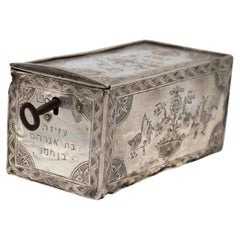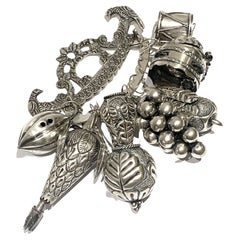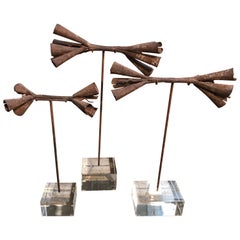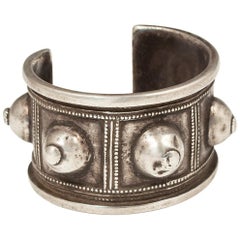Algerian Tribal Art
to
1
2
1
1
1
2
1
1
67
790
653
355
185
2
2
2
Place of Origin: Algerian
19th Century Kabyle Flyssa Sword with Inlaid Blade & Original Scabbard – Algeria
Located in London, GB
19th Century Kabyle Flyssa Sword – Algeria
A finely crafted long-bladed Flyssa sword from northern Algeria, traditional to the Kabyle Iflissen-im-Bahr tribe. This example features...
Category
Early 20th Century Algerian Tribal Art
Materials
Metal
extremely rare Algerian Judaica silver, jewish Dowry box early 19th century
Located in Tel Aviv - Jaffa, IL
Amazing and scarce JUDAICA object, we have here one of the most touching jewish objects we had for a long time, this small silver dowry box was made in Algeria in the early 19th century, it is all covered with symbols of jewish faith and of couples, the sliding lid has 2 flanking birds with hamsa (protective hand) on each side and a flower vase in the middle.
one side shows two flanking lions with a tree in the middle and the other side shows again two big and two small birds with a flower bowl in the middle, front side has a key hole and next to it there is the Hebrew inscription ס״ט״" which says Siman tov or in English "a good sign" it is taken from the wedding blessing, underneath the lock there is another inscription with the name ״עזיזה בת אברהם בן חמו״ which is the name of the bride, her father and her grandfathers name.
the box is full marked a lot of times with the silversmith mark, every side of the box is marked.
this box was probably ordered by the grooms family to hold the jewelry they are giving to the bride as dowry, this type of objects are rare and there are just a few of them on museum collections.
DOWRY (Heb. נְדֻנְיָה), the property a wife brings to her husband at marriage; the Yiddish equivalent, nadn, is from the same root. The custom of nedunyah became clearly defined and institutionalized only in the talmudic period. In biblical times, mohar (מֹהַר), whereby the groom bought his wife from her father (Gen. 24:53; Ex. 22:15–16; Hos. 3:2), was the accepted practice. It was then customary that the groom give the bride gifts, and that she bring certain property to her husband's home upon marriage: slaves, cattle, real estate, etc. (cf. Gen. 24:59–61; 29; Judg. 1:14ff.; I Kings 9:16). Evidence of the custom of nedunyah is to be found in Tobit (7:14; 8:21) and in the Assuan papyri (Cowley, Aramaic, nos. 15, 18). Gradually, mohar was superseded by the ketubbah custom according to which the husband merely assumed the responsibility of compensation to his wife in case he divorced her: he had to pay her 200 zuzim if she had been a virgin at the time of marriage, and 100 zuzim if a widow or divorcée (see *Ketubbah).
By talmudic times, the institution of nedunyah was prevalent; the father gave a dowry to the bride since the daughter was excluded from paternal inheritance. Fifty zuzim (equivalent to the worth of 180 grams of silver) was the minimum amount a father was obliged to give to his daughter (Ket. 6:5). Parents usually gave much more, according to their social standing. Community funds provided the dowry for an orphan or a very poor girl (ibid.; cf. Sh. Ar., YD 251:8). In case of her father's death, the brothers of a minor girl were obliged to give her the minimum dowry, and the court estimated how much her father would have given her above the minimum dowry. The sum was then taken out of the father's estate and given to the daughter upon majority (Ket. 6:6; 68a–69b). In the absence of such an estimate, each daughter was entitled to receive one-tenth of the value of her father's estate in money, or in valuables (Yad, Ishut, 20:4–7; Sh. Ar., EH 113:4). If the father was unable or unwilling to pay the promised dowry at the betrothal ceremony, the groom could refuse to marry his bride (Ket. 13:5; Ket. 108b–109a). Insistence on exact payment of the promised dowry, however, was frowned upon by later rabbinic authorities (Rema to Sh. Ar., EH 2:1). In certain communities it was customary for the groom's father to make a dowry contribution equal to that of the bride's father (Ket. 102b). The dowry, whether given in real estate, slaves, money, or chattel was recorded in the marriage contract (the ketubbah) and in some instances one-third or one-fifth of the actual value of the dowry was added to the sum mentioned in the ketubbah. Based upon a decree enacted by *Simeon b. Shetah (first century C.E.), the Talmud ruled that the husband and his entire property were liable for compensation as stipulated in the ketubbah, either in case he died (when she collected the sum specified in the ketubbah from the heirs) or in case he divorced his wife (Ket. 82b). For the status of the dowry and the husband's rights and obligations, see below. The rabbinic enactments (Takkanot Shum) by R. Jacob *Tam and by the rabbinic synod of the communities of Speyer, Worms, and Mainz (Germany) stipulated that if a woman died...
Category
Mid-19th Century Antique Algerian Tribal Art
Materials
Silver
Related Items
Rare Silver Balangandãs - 20th Century Brazilian Native Hanging Amulet
Located in Rio De Janeiro, BR
Mid 20th century brazilian silver hanging amulet from native culture in Brazil. Known as "Penca de Balangandãs" was used in the ancient times as an amul...
Category
Mid-20th Century Other Algerian Tribal Art
Materials
Sterling Silver
African Currency, 19th Century
Located in Dallas, TX
This set of 3 pieces of African currency is very interesting. Looking like some sort of ancient maraca, these 19th century pieces jingle and noise-make with each step. The dimensions...
Category
19th Century Antique Algerian Tribal Art
Materials
Metal
Late 19th Century Door Panels with Latticework and Carvings
Located in Singapore, SG
Late 19th century door panels with lattice patterns and carvings from Jiangxi province, China.
This set of doors have a very beautiful and highly unusual lattice pattern. Besides th...
Category
Late 19th Century Qing Antique Algerian Tribal Art
Materials
Pine
Chinese Paktong Basin, 19th Century
Located in Lymington, Hampshire
A Chinese paktong basin, engraved with scenes of many children at play and before pagodas, within borders of shou characters, bats and flowerheads, the flattened rim with vases of flowers and lingzhi, swords, lotus pods...
Category
19th Century Meiji Antique Algerian Tribal Art
Materials
Metal
19th or Early 20th Century Tribal Copper Snake Currency Sculpture Zaire Africa
Located in Point Richmond, CA
19th or early 20th century copper snake currency sculpture Zaire Africa
Ngelima culture, Zaire, hand-forged, copper rod in an anthropomorphic styli...
Category
Late 19th Century Other Antique Algerian Tribal Art
Materials
Copper
19th century Antique Woven Basket
Located in New York, NY
19th century antique woven basket. Decorative basket. This is an actual antique market basket in very good condition. Woven reed, bamboo, and woo...
Category
1890s Qing Antique Algerian Tribal Art
Materials
Reed, Bamboo, Wood
Late 19th-Early 20th Century Hand-Forged Iron Currency, Southern Chad, Africa
Located in Point Richmond, CA
Late 19th-early 20th century iron currency, kurr, Sara-Madjingaye peoples, Southern Chad.
These rare currencies have a wonderfully minimalist anthropomorphic form, but were inspired...
Category
Early 20th Century Tribal Algerian Tribal Art
Materials
Iron
19th Century Ethiopian Throne
Located in London, GB
This large, impressive nineteenth-century Ethiopian throne, from the Wollega Oromo culture, features a high, upright back-rest.
An attractive cut-ou...
Category
Late 19th Century Tribal Antique Algerian Tribal Art
Materials
Wood
Australian boomerang, 19th century
Located in 'S-HERTOGENBOSCH, NL
A 19th century boomerang from Australia.
Good patina and presented on a stand.
Category
Late 19th Century Tribal Antique Algerian Tribal Art
Materials
Wood
19th Century Thai Ceremonial Drum with Ropes and Leather Drumhead
Located in Yonkers, NY
An antique Thai ceremonial wooden drum from the 19th century, with leather drumhead. Sculptural and freestanding, this 19th century drum, created in Thailand, will make for a great decorative accentuation in any home. Topped with a leather drumhead secured with ropes, the drum is adorned with carved motifs on the belly. With its slender silhouette and rustic appearance, this antique Thai drum...
Category
19th Century Antique Algerian Tribal Art
Materials
Leather, Rope, Wood
19th Century Chinese Wedding Cabinet
Located in Rochester, NY
Antique Chinese wedding cabinet in beautifully aged original burnt sienna red stained finish that compliments the grain of wood. Two do...
Category
19th Century Antique Algerian Tribal Art
Materials
Brass
Wooden Make-up Box From The Kuba Tribe, Dr Congo, late 19th century
By Kuba
Located in Bilzen, BE
A very old wooden make-up box Circa: late 19th century
Origin: DR Congo
Very rich tribal aged patina and traces
9.5 x 15.5 cm, height 9 cm
Category
Late 19th Century Tribal Antique Algerian Tribal Art
Materials
Wood
Previously Available Items
Early to Mid-20th Century Silver Tribal Bracelet, Algeria, North Africa
Located in Point Richmond, CA
Early to mid-20th century silver tribal bracelet, Algeria, North Africa.
A very wearable silver cuff from Algeria with an opening of 1.25" (3.1 cm). The interior circumference is 6...
Category
Early 20th Century Tribal Algerian Tribal Art
Materials
Silver




